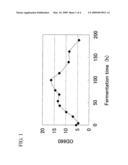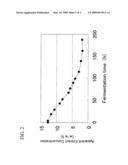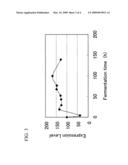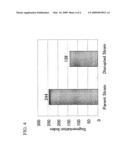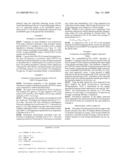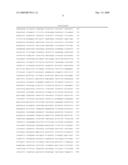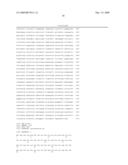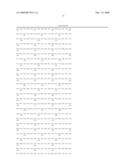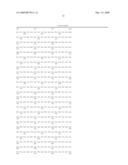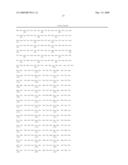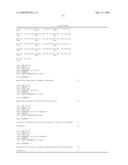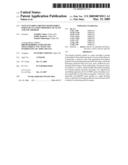Patent application title: Gene Encoding Protein Responsible for Flocculation Property of Yeast and Use Thereof
Inventors:
Yoshihiro Nakao (Osaka, JP)
Yukiko Kodama (Osaka, JP)
Tomoko Shimonaga (Osaka, JP)
Assignees:
SUNTORY LIMITED
IPC8 Class: AC12G300FI
USPC Class:
426 12
Class name: Fermentation processes alcoholic beverage production or treatment to result in alcoholic beverage addition of enzyme containing material to alcohol containing beverage to stabilize, purify, or prevent turbidity formation
Publication date: 2009-03-19
Patent application number: 20090074913
Claims:
1. A polynucleotide selected from the group consisting of:(a) a
polynucleotide comprising a polynucleotide consisting of the nucleotide
sequence of SEQ ID NO: 1;(b) a polynucleotide comprising a polynucleotide
encoding a protein consisting of the amino acid sequence of SEQ ID NO:
2;(c) a polynucleotide comprising a polynucleotide encoding a protein
consisting of the amino acid sequence of SEQ ID NO: 2 with one or more
amino acids thereof being deleted, substituted, inserted and/or added,
and having an activity of imparting flocculation property to yeast;(d) a
polynucleotide comprising a polynucleotide encoding a protein having an
amino acid sequence having 60% or higher identity with the amino acid
sequence of SEQ ID NO: 2, and said protein having an activity of
imparting flocculation property to yeast;(e) a polynucleotide comprising
a polynucleotide which hybridizes to a polynucleotide consisting of a
nucleotide sequence complementary to the nucleotide sequence of SEQ ID
NO: 1 under stringent conditions, and which encodes a protein an activity
of imparting flocculation property to yeast; and(f) a polynucleotide
comprising a polynucleotide which hybridizes to a polynucleotide
consisting of a nucleotide sequence complementary to the nucleotide
sequence of the polynucleotide encoding the protein of the amino acid
sequence of SEQ ID NO:2 under stringent conditions, and which encodes a
protein having an activity of imparting flocculation property to yeast.
2. The polynucleotide of claim 1 selected from the group consisting of:(a) a polynucleotide encoding a protein consisting of the amino acid sequence of SEQ ID NO: 2, or encoding an amino acid sequence of SEQ ID NO: 2 wherein 1 to 10 amino acids thereof is deleted, substituted, inserted, and/or added, and wherein said protein has an activity of imparting flocculation property to yeast;(b) a polynucleotide encoding a protein having 90% or higher identity with the amino acid sequence of SEQ ID NO: 2, and having an activity of imparting flocculation property to yeast; and(c) a polynucleotide which hybridizes to SEQ ID NO: 1 or which hybridizes to a nucleotide sequence complementary to the nucleotide sequence of SEQ ID NO: 1 under stringent conditions, and which encodes a protein having an activity of imparting flocculation property to yeast.
3. The polynucleotide of claim 1 comprising a polynucleotide consisting of the nucleotide sequence of SEQ ID NO: 1.
4. The polynucleotide of claim 1 comprising a polynucleotide encoding a protein consisting of the amino acid sequence SEQ ID NO: 2.
5. The polynucleotide according to claim 1, wherein the polynucleotide is DNA.
6. A polynucleotide selected from the group consisting of:(a) a polynucleotide encoding RNA having a nucleotide sequence complementary to a transcript of the polynucleotide (DNA) according to claim 5;(b) a polynucleotide encoding RNA that represses the expression of the polynucleotide (DNA) according to claim 5 through an RNAi effect;(c) a polynucleotide encoding RNA having an activity of specifically cleaving a transcript of the polynucleotide (DNA) according to claim 5; and(d) a polynucleotide encoding RNA that represses the expression of the polynucleotide (DNA) according to claim 5 through a co-suppression effect.
7. A protein encoded by the polynucleotide of claim 1.
8. A vector containing the polynucleotide of claim 1.
9. A vector containing the polynucleotide according to claim 6.
10. A yeast into which the vector according to claim 8 has been introduced.
11. The yeast according to claim 10, wherein the flocculation property is increased.
12. The yeast according to claim 11, wherein the flocculation property is increased by increasing an expression level of protein encoded by the polynucleotide.
13. A yeast, wherein the expression of the polynucleotide is DNA and is repressed by:(A) introducing the vector according to claim 8;(B) disrupting the gene according to the DNA polynucleotide; or(C) introducing a mutation into a promoter or genetically altering a promoter.
14. The yeast according to claim 13, wherein the flocculation property is decreased.
15. A method for producing an alcoholic beverage by using the yeast according to claim 10.
16. A method according to claim 15, wherein the brewed alcoholic beverage is a malt beverage.
17. A method according to claim 15, wherein the brewed alcoholic beverage is wine.
18. An alcoholic beverage produced by the method according to claim 15.
19. A method for assessing a test yeast for its flocculation property, comprising suing a primer or probe designed based on the nucleotide sequence of a gene having the nucleotide sequence of SEQ ID NO: 1 and encoding a protein having an activity of imparting flocculation property to yeast.
20. A method for assessing a test yeast for its flocculation property, comprising: culturing the test yeast; and measuring the expression level of the gene having the nucleotide sequence of SEQ ID NO: 1 and encoding a protein having an activity of imparting flocculation property to yeast.
21. A method for selecting a yeast, comprising: culturing test yeasts; quantifying the protein of claim 7 or measuring the expression level of the gene having the nucleotide sequence of SEQ ID NO: 1 and encoding a protein having an activity of imparting flocculation property to yeast; and selecting a test yeast having an amount of the protein or the gene expression level according to the flocculation property of interest.
22. The method for selecting a yeast according to claim 21, comprising: culturing a reference yeast and test yeasts; measuring for each yeast the expression level of the gene having the nucleotide sequence of SEQ ID NO: 1 and encoding a protein having an activity of imparting flocculation property to yeast; and selecting a test yeast having the gene expression higher or lower than that in the reference yeast.
23. The method for selecting a yeast according to claim 21, comprising: culturing a reference yeast and test yeasts; quantifying the protein encoded by the polynucleotide in each yeast; and selecting a test yeast having a larger or smaller amount of the protein than that in the reference yeast.
24. A method for producing an alcoholic beverage comprising: conducting fermentation for producing an alcoholic beverage using:(a) a yeast comprising a vector containing a polynucleotide selected from the group consisting of:(i) a polynucleotide comprising a polynucleotide consisting of the nucleotide sequence of SEQ ID NO: 1;(ii) a polynucleotide comprising a polynucleotide encoding a protein consisting of the amino acid sequence of SEQ ID NO: 2;(iii) a polynucleotide comprising a polynucleotide encoding a protein consisting of the amino acid sequence of SEQ ID NO: 2 with one or more amino acids thereof being deleted, substituted, inserted and/or added, and having an activity of imparting flocculation property to yeast;(iv) a polynucleotide comprising a polynucleotide encoding a protein having an amino acid sequence having 60% or higher identity with the amino acid sequence of SEQ ID NO: 2, and said protein having an activity of imparting flocculation property to yeast;(v) a polynucleotide comprising a polynucleotide which hybridizes to a polynucleotide consisting of a nucleotide sequence complementary to the nucleotide sequence of SEQ ID NO: 1 under stringent conditions, and which encodes a protein an activity of imparting flocculation property to yeast; and(vi) a polynucleotide comprising a polynucleotide which hybridizes to a polynucleotide consisting of a nucleotide sequence complementary to the nucleotide sequence of the polynucleotide encoding the protein of the amino acid sequence of SEQ ID NO: 2 under stringent conditions, and which encodes a protein having an activity of imparting flocculation property to yeast; or(b) a yeast selected by the method according to claim 21, andadjusting flocculation property of yeast.
Description:
TECHNICAL FIELD
[0001]The present invention relates to a gene encoding a protein responsible for flocculation property of yeast and use thereof, in particular, a brewery yeast for producing alcoholic beverages with appropriate flocculation property, alcoholic beverages produced with said yeast, and a method for producing said beverages. More particularly, the present invention relates to a yeast, which shows appropriate flocculation property by controlling expression level of MHP1 gene encoding a protein responsible for flocculation property of brewery yeast, especially non-ScMHP1 gene specific to a lager brewing yeast, to a method for selecting said yeast, to a method for breeding said yeast and to a method for producing alcoholic beverages with said yeast.
BACKGROUND ART
[0002]Flocculation property of yeast used for fermentation in alcoholic beverages is very important. Flocculation property of yeast means property of forming aggregation as a result of interaction among each individual yeast cells, thus sedimenting to the bottom of the liquid in a liquid culture medium.
[0003]For example, yeasts used for fermentation of lager-type beer, which is popularly drunk at the present day, are also called bottom fermenting yeast, because the yeast have a character of flocculating and sedimenting to the bottom of fermentation broth near the end of fermentation. In beer brewing, yeast is recovered after fermentation and the recovered yeast is used at the subsequent fermentation, which is called "Renjo" which means successive fermentation. Thus, flocculation property of yeast is very important property from the standpoint of working efficiency of brewing process. That is, yeast having poor flocculation property does not sediment at the end of fermentation, and there is a problem that extraneous steps such as centrifugation are required for recover it. On the other hand, yeast having undesirably high flocculation property may sediment during fermentation, which can result in immature termination of fermentation. In that case, flavor and taste of resultant product are also seriously influenced. Accordingly, it is very important to use yeast having suitable flocculation property for production of desired alcoholic beverages.
[0004]Further, flocculation of yeast is actively studied, because efficiency is required especially in the field of industrial alcohol production (Novel agglutinative alcohol fermenting yeast, Japanese Examined Patent Publication (Kokoku) No. H6-36734) and wastewater treatment (Japanese Patent No. 3044284), as well as in the field of alcoholic beverage production.
[0005]FLO gene family (FLO1, FLO5, FLO8, FLO9, FLO10, FLO11) and SFL1, etc. have ever been recognized as genes responsible for flocculation property of yeast as a result of enormous quantity of investigations on flocculation property, which is of importance for industry, of yeast as stated above.
[0006]In the investigation, for example, property of FLO1 gene was analyzed at molecular level (Bidard et al., YEAST, 11(9), 809, 1995). Method for controlling flocculation property of beer yeast was investigated as well using Flo1p (Japanese Patent No. 3643404).
[0007]Method of controlling flocculation property of yeast by regulating expression of FLO8 gene, and method of judging flocculating property using nucleotide sequence of FLO5 gene (International Publication No. WO01/040514), etc. are also reported.
[0008]On the other hand, some of yeast cell surface proteins specific to flocculating yeast are known as well. However, knowledge of each proteins is not sufficient for research to control flocculation property of beer yeast.
DISCLOSURE OF INVENTION
[0009]Under the above situations, there has been a need for breeding yeasts having flocculation property suitable for production of desired alcoholic beverages to make high-efficiency production of alcoholic beverages possible by using a gene encoding a protein responsible for flocculation property of brewery yeast and said protein.
[0010]The present inventors made extensive studies to solve the above problems and as a result, succeeded in identifying and isolating a gene encoding a protein responsible for flocculation property of yeast from beer yeast. Moreover, the present inventors produced transformed yeast in which expression of the obtained gene was controlled to verify that flocculation property can be actually controlled, thereby completing the present invention.
[0011]Thus, the present invention relates to a gene encoding a protein responsible for flocculation property of brewery yeast, to a protein encoded by said gene, to a transformed yeast in which the expression of said gene is controlled, to a method for controlling flocculation property using a yeast in which the expression of said gene is controlled, or the like. More specifically, the present invention provides the following polynucleotides, a vector or a DNA fragment comprising said polynucleotide, a transformed yeast introduced with said vector or DNA fragment, a method for producing alcoholic beverages by using said transformed yeast, and the like.
[0012](1) A polynucleotide selected from the group consisting of:
[0013](a) a polynucleotide comprising a polynucleotide consisting of the nucleotide sequence of SEQ ID NO:1;
[0014](b) a polynucleotide comprising a polynucleotide encoding a protein consisting of the amino acid sequence of SEQ ID NO:2;
[0015](c) a polynucleotide comprising a polynucleotide encoding a protein consisting of the amino acid sequence of SEQ ID NO:2 in which one or more amino acids thereof are deleted, substituted, inserted and/or added, and having an activity of imparting flocculation property to yeast;
[0016](d) a polynucleotide comprising a polynucleotide encoding a protein having an amino acid sequence having 60% or higher identity with the amino acid sequence of SEQ ID NO:2, and said protein having an activity of imparting flocculation property to yeast;
[0017](e) a polynucleotide comprising a polynucleotide which hybridizes to a polynucleotide consisting of a nucleotide sequence complementary to the nucleotide sequence of SEQ ID NO:1 under stringent conditions, and which encodes a protein having an activity of imparting flocculation property to yeast; and
[0018](f) a polynucleotide comprising a polynucleotide which hybridizes to a polynucleotide consisting of a nucleotide sequence complementary to the nucleotide sequence of the polynucleotide encoding the protein having the amino acid sequence of SEQ ID NO:2 under stringent conditions, and which encodes a protein having an activity of imparting flocculation property to yeast.
[0019](2) The polynucleotide according to (1) above selected from the group consisting of:
[0020](g) a polynucleotide comprising a polynucleotide encoding a protein consisting of the amino acid sequence of SEQ ID NO: 2, or encoding the amino acid sequence of SEQ ID NO: 2 in which 1 to 10 amino acids thereof are deleted, substituted, inserted, and/or added, and wherein said protein has an activity of imparting flocculation property to yeast;
[0021](h) a polynucleotide comprising a polynucleotide encoding a protein having 90% or higher identity with the amino acid sequence of SEQ ID NO: 2, and having an activity of imparting flocculation property to yeast; and
[0022](i) a polynucleotide comprising a polynucleotide which hybridizes to a polynucleotide consisting of a nucleotide sequence of SEQ ID NO: 1 or which hybridizes to a polynucleotide consisting of a nucleotide sequence complementary to the nucleotide sequence of SEQ ID NO: 1, under high stringent conditions, which encodes a protein having an activity of imparting flocculation property to yeast.
[0023](3) The polynucleotide according to (1) above comprising a polynucleotide consisting of the nucleotide sequence of SEQ ID NO: 1.
[0024](4) The polynucleotide according to (1) above comprising a polynucleotide encoding a protein consisting of the amino acid sequence of SEQ ID NO: 2.
[0025](5) The polynucleotide according to any one of (1) to (4) above, wherein the polynucleotide is DNA.
[0026](6) A polynucleotide selected from the group consisting of:
[0027](j) a polynucleotide encoding RNA having a nucleotide sequence complementary to a transcript of the polynucleotide (DNA) according to (5) above;
[0028](k) a polynucleotide encoding RNA that represses the expression of the polynucleotide (DNA) according to (5) above through an RNAi effect;
[0029](l) a polynucleotide encoding RNA having an activity of specifically cleaving a transcript of the polynucleotide (DNA) according to (5) above; and
[0030](m) a polynucleotide encoding RNA that represses the expression of the polynucleotide (DNA) according to (5) above through a co-suppression effect.
[0031](7) A protein encoded by the polynucleotide according to any one of (1) to (5) above.
[0032](8) A vector containing the polynucleotide according to any one of (1) to (5) above.
[0033](8a) The vector of (8) above, which comprises the expression cassette comprising the following components:
[0034](x) a promoter that can be transcribed in a yeast cell;
[0035](y) any of the polynucleotides described in (1) to (5) above linked to the promoter in a sense or antisense direction; and
[0036](z) a signal that can function in a yeast with respect to transcription termination and polyadenylation of a RNA molecule.
[0037](8b) The vector of (8) above, which comprises the expression cassette comprising the following components:
[0038](x) a promoter that can be transcribed in a yeast cell;
[0039](y) any of the polynucleotides described in (1) to (5) above linked to the promoter in a sense direction; and
[0040](z) a signal that can function in a yeast with respect to transcription termination and polyadenylation of a RNA molecule.
[0041](8c) The vector of (8) above, which comprises the expression cassette comprising the following components:
[0042](x) a promoter that can be transcribed in a yeast cell;
[0043](y) any of the polynucleotides described in (1) to (5) above linked to the promoter in a antisense direction; and
[0044](z) a signal that can unction in a yeast with respect to transcription termination and polyadenylation of a RNA molecule.
[0045](9) A vector containing the polynucleotide according to (6) above.
[0046](10) A yeast into which the vector according to any one of (8) to (9) above has been introduced.
[0047](11) The yeast according to (10) above, wherein the flocculation property is increased.
[0048](12) The yeast according to (11) above, wherein the flocculation property is increased by increasing an expression level of the protein of (7) above.
[0049](13) A yeast, wherein the expression of the polynucleotide (DNA) according to (5) above is repressed by:
[0050](A) introducing the vector according to any one of (8) to (9) above;
[0051](B) disrupting the gene according to the polynucleotide (DNA) of (5) above; or
[0052](C) introducing a mutation into a promoter or genetically altering a promoter.
[0053](14) The yeast according to (13) above, wherein the flocculation property is decreased.
[0054](15) A method for producing an alcoholic beverage by using the yeast according to any one of (10) to (14) above.
[0055](16) The method according to (15) above, wherein the brewed alcoholic beverage is a malt beverage.
[0056](17) The method according to (15) above, wherein the brewed alcoholic beverage is wine.
[0057](18) An alcoholic beverage produced by the method according to any one of (15) to (17) above.
[0058](19) A method for assessing a test yeast for its flocculation property, comprising using a primer or probe designed based on the nucleotide sequence of a gene having the nucleotide sequence of SEQ ID NO: 1 and encoding a protein having an activity of imparting flocculation property to yeast.
[0059](19a) A method for selecting a yeast having a high or low flocculation property by using the method in (19) above.
[0060](19b) A method for producing an alcoholic beverage (for example, beer) by using the yeast selected with the method in (19a) above.
[0061](20) A method for assessing a test yeast for its flocculation property, comprising: culturing the test yeast; and measuring the expression level of the gene having the nucleotide sequence of SEQ ID NO: 1 and encoding a protein having an activity of imparting flocculation property to yeast.
[0062](20a) A method for selecting a yeast, which comprises assessing a test yeast by the method described in (20) above and selecting a yeast having a high or low expression level of gene encoding a protein having an activity of imparting flocculation property to yeast.
[0063](20b) A method for producing an alcoholic beverage (for example, beer) by using the yeast selected with the method in (20a) above.
[0064](21) A method for selecting a yeast, comprising: culturing test yeasts; quantifying the protein of (7) above or measuring the expression level of the gene having the nucleotide sequence of SEQ ID NO: 1 and encoding a protein having an activity of imparting flocculation property to yeast; and selecting a test yeast having an amount of the protein or the gene expression level according to the flocculation property of interest.
[0065](22) The method for selecting a yeast according to (21) above, comprising: culturing a reference yeast and test yeasts; measuring for each yeast the expression level of the gene having the nucleotide sequence of SEQ ID NO: 1 and encoding a protein having an activity of imparting flocculation property to yeast; and selecting a test yeast having the gene expression higher or lower than that in the reference yeast.
[0066](23) The method for selecting a yeast according to (21) above, comprising: culturing a reference yeast and test yeasts; quantifying the protein according to (7) above in each yeast; and selecting attest yeast having a larger or smaller amount of the protein than that in the reference yeast. That is, the method for selecting a yeast of (21) above, comprising: culturing plural yeasts; quantifying the protein of (7) above in each yeast; and selecting a yeast having a larger or smaller amount of the protein among them.
[0067](24) A method for producing an alcoholic beverage comprising: conducting fermentation for producing an alcoholic beverage using the yeast according to any one of (10) to (14) above or a yeast selected by the methods according to any one of (21) to (23) above, and adjusting flocculation property of yeast.
[0068]According to the method for producing alcoholic beverages using transformed yeast of the present invention, alcoholic beverages can be produced highly-efficiently by using yeasts having flocculation property suitable for production of desired alcoholic beverages.
BRIEF DESCRIPTION OF DRAWINGS
[0069]FIG. 1 shows the cell growth with time upon beer fermentation test. The horizontal axis represents fermentation time while the vertical axis represents optical density at 660 nm (OD660).
[0070]FIG. 2 shows the extract (sugar) consumption with time upon beer fermentation test. The horizontal axis represents fermentation time while the vertical axis represents apparent extract concentration (w/w %).
[0071]FIG. 3 shows the expression profile of non-ScMHP1 gene in yeasts upon beer fermentation test. The horizontal axis represents fermentation time while the vertical axis represents the intensity of detected signal.
[0072]FIG. 4 shows the result of flocculation property test of non-ScMHP1 disrupted strain. The vertical axis represents Segmentation Index indicating flocculation property.
BEST MODES FOR CARRYING OUT THE INVENTION
[0073]The present inventors isolated and identified non-ScMHP1 gene encoding a protein responsible for flocculation property of brewery yeast based on the lager brewing yeast genome information mapped according to the method disclosed in Japanese Patent Application Laid-Open No. 2004-283169. The nucleotide sequence of the gene is represented by SEQ ID NO: 1. Further, an amino acid sequence of a protein encoded by the gene is represented by SEQ ID NO: 2.
1. Polynucleotide of the Invention
[0074]First of all, the present invention provides (a) a polynucleotide comprising a polynucleotide of the nucleotide sequence of SEQ ID NO:1; and (b) a polynucleotide comprising a polynucleotide encoding a protein of the amino acid sequence of SEQ ID NO:2. The polynucleotide can be DNA or RNA.
[0075]The target polynucleotide of the present invention is not limited to the polynucleotide encoding a protein responsible for flocculation property derived from lager brewing yeast described above and may include other polynucleotides encoding proteins having equivalent functions to said protein. Proteins with equivalent functions include, for example, (c) a protein of an amino acid sequence of SEQ ID NO:2 with one or more amino acids thereof being deleted, substituted, inserted and/or added and imparting flocculation property to yeast.
[0076]Such proteins include a protein consisting of an amino acid sequence of SEQ ID NO:2 with, for example, 1 to 100, 1 to 90, 1 to 80, 1 to 70, 1 to 60, 1 to 50, 1 to 40, 1 to 39, 1 to 38, 1 to 37, 1 to 36, 1 to 35, 1 to 34, 1 to 33, 1 to 32, 1 to 31, 1 to 30, 1 to 29, 1 to 28, 1 to 27, 1 to 26, 1 to 25, 1 to 24, 1 to 23, 1 to 22, 1 to 21, 1 to 20, 1 to 19, 1 to 18, 1 to 17, 1 to 16, 1 to 15, 1 to 14, 1 to 13, 1 to 12, 1 to 11, 1 to 10, 1 to 9, 1 to 8, 1 to 7, 1 to 6 (1 to several amino acids), 1 to 5, 1 to 4, 1 to 3, 1 to 2, or 1 amino acid residues thereof being deleted, substituted, inserted and/or added and imparting flocculation property to yeast. In general, the number of deletions, substitutions, insertions, and/or additions is preferably smaller. In addition, such proteins include (d) a protein having an amino acid sequence with about 60% or higher, about 70% or higher, 71% or higher, 72% or higher, 73% or higher, 74% or higher, 75% or higher, 76% or higher, 77% or higher, 78% or higher, 79% or higher, 80% or higher, 81% or higher, 82% or higher, 83% or higher, 84% or higher, 85% or higher, 86% or higher, 87% or higher, 88% or higher, 89% or higher, 90% or higher, 91% or higher, 92% or higher, 93% or higher, 94% or higher, 95% or higher, 96% or higher, 97% or higher, 98% or higher, 99% or higher, 99.1% or higher, 99.2% or higher, 99.3% or higher, 99.4% or higher, 99.5% or higher, 99.6% or higher, 99.7% or higher, 99.8% or higher, or 99.9% or higher identity with the amino acid sequence of SEQ ID NO:2, and imparting flocculation property to yeast. In general, the percentage identity is preferably higher.
[0077]Flocculation property of yeast may be measured, for example, by a method described in Japanese Patent Application Laid-Open No. H8-205890.
[0078]Furthermore, the present invention also contemplates (e) a polynucleotide comprising a polynucleotide which hybridizes to a polynucleotide consisting of a nucleotide sequence complementary to the nucleotide sequence of SEQ ID NO:1 under stringent conditions and which encodes a protein imparting flocculation property to yeast; and (f) a polynucleotide comprising a polynucleotide which hybridizes to a polynucleotide complementary to a nucleotide sequence of encoding a protein of SEQ ID NO:2 under stringent conditions, and which encodes a protein imparting flocculation property to yeast.
[0079]Herein, "a polynucleotide that hybridizes under stringent conditions" refers to nucleotide sequence, such as a DNA, obtained by a colony hybridization technique, a plaque hybridization technique, a southern hybridization technique or the like using all or part of polynucleotide of a nucleotide sequence complementary to the nucleotide sequence of SEQ ID NO: 1 or polynucleotide encoding the amino acid sequence of SEQ ID NO:2 as a probe. The hybridization method may be a method described, for example, in MOLECULAR CLONING 3rd Ed., CURRENT PROTOCOLS IN MOLECULAR BIOLOGY, John Wiley & Sons 1987-1997, and so on.
[0080]The term "stringent conditions" as used herein may be any of low stringency conditions, moderate stringency conditions or high stringency conditions. "Low stringency conditions" are, for example, 5×SSC, 5× Denhardt's solution, 0.5% SDS, 50% formamide at 32° C. "Moderate stringency conditions" are, for example, 5×SSC, 5× Denhardt's solution, 0.5% SDS, 50% formamide at 42° C. "High stringency conditions" are, for example, 5×SSC, 5× Denhardt's solution, 0.5% SDS, 50% formamide at 50° C. Under these conditions, a polynucleotide, such as a DNA, with higher homology is expected to be obtained efficiently at higher temperature, although multiple factors are involved in hybridization stringency including temperature, probe concentration, probe length, ionic strength, time, salt concentration and others, and one skilled in the art may appropriately select these factors to realize similar stringency.
[0081]When a commercially available kit is used for hybridization, for example, Alkphos Direct Labeling Reagents (Amersham Pharmacia) may be used. In this case, according to the attached protocol, after incubation with a labeled probe overnight, the membrane is washed with a primary wash buffer containing 0.1% (w/v) SDS at 55° C., thereby detecting hybridized polynucleotide, such as DNA.
[0082]Other polynucleotides that can be hybridized include polynucleotides having about 60% or higher, about 70% or higher, 71% or higher, 72% or higher, 73% or higher, 74% or higher, 75% or higher, 76% or higher, 77% or higher, 78% or higher, 79% or higher, 80% or higher, 81% or higher, 82% or higher, 83% or higher, 84% or higher, 85% or higher, 86% or higher, 87% or higher, 88% or higher, 89% or higher, 90% or higher, 91% or higher, 92% or higher, 93% or higher, 94% or higher, 95% or higher, 96% or higher, 97% or higher, 98% or higher, 99% or higher, 99.1% or higher, 99.2% or higher, 99.3% or higher, 99.4% or higher, 99.5% or higher, 99.6% or higher, 99.7% or higher, 99.8% or higher or 99.9% or higher identity to polynucleotide encoding the amino acid sequence of SEQ ID NO:2 as calculated by homology search software, such as FASTA and BLAST using default parameters.
[0083]Identity between amino acid sequences or nucleotide sequences may be determined using algorithm BLAST by Karlin and Altschul (Proc. Natl. Acad. Sci. USA, 87: 2264-2268, 1990; Proc. Natl. Acad. Sci. USA, 90: 5873, 1993). Programs called BLASTN and BLASTX based on BLAST algorithm have been developed (Altschul S F et al., J. Mol. Biol. 215: 403, 1990). When a nucleotide sequence is sequenced using BLASTN, the parameters are, for example, score=100 and word length=12. When an amino acid sequence is sequenced using BLASTX the parameters are, for example, score=50 and word length=3. When BLAST and Gapped BLAST programs are used, default parameters for each of the programs are employed.
[0084]The polynucleotide of the present invention includes (j) a polynucleotide encoding RNA having a nucleotide sequence complementary to a transcript of the polynucleotide (DNA) according to (5) above; (k) a polynucleotide encoding RNA that represses the expression of the polynucleotide (DNA) according to (5) above through RNAi effect; (l) a polynucleotide encoding RNA having an activity of specifically cleaving a transcript of the polynucleotide (DNA) according to (5) above; and (m) a polynucleotide encoding RNA that represses expression of the polynucleotide (DNA) according to (5) above through co-supression effect. These polynucleotides may be incorporated into a vector, which can be introduced into a cell for transformation to repress the expression of the polynucleotides (DNA) of (a) to (i) above. Thus, these polynucleotides may suitably be used when repression of the expression of the above DNA is preferable.
[0085]The phrase "polynucleotide encoding RNA having a nucleotide sequence complementary to the transcript of DNA" as used herein refers to so-called antisense DNA. Antisense technique is known as a method for repressing expression of a particular endogenous gene, and is described in various publications (see e.g., Hirajima and Inoue: New Biochemistry Experiment Course 2 Nucleic Acids IV Gene Replication and Expression (Japanese Biochemical Society Ed., Tokyo Kagaku Dozin Co., Ltd.) pp. 319-347, 1993). The sequence of antisense DNA is preferably complementary to all or part of the endogenous gene, but may not be completely complementary as long as it can effectively repress the expression of the gene. The transcribed RNA has preferably 90% or higher, and more preferably 95% or higher complementarity to the transcript of the target gene. The length of the antisense DNA is at least 15 bases or more, preferably 100 bases or more, and more preferably 500 bases or more.
[0086]The phrase "polynucleotide encoding RNA that represses DNA expression through RNAi effect" as used herein refers to a polynucleotide for repressing expression of an endogenous gene through RNA interference (RNAi). The term "RNAi" refers to a phenomenon where when double-stranded RNA having a sequence identical or similar to the target gene sequence is introduced into a cell, the expressions of both the introduced foreign gene and the target endogenous gene are repressed. RNA as used herein includes, for example, double-stranded RNA that causes RNA interference of 21 to 25 base length, for example, dsRNA (double strand RNA), siRNA (small interfering RNA) or shRNA (short hairpin RNA). Such RNA may be locally delivered to a desired site with a delivery system such as liposome, or a vector that generates the double-stranded RNA described above may be used for local expression thereof. Methods for producing or using such double-stranded RNA (dsRNA, siRNA or shRNA) are known from many publications (see, e.g., Japanese National Phase PCT Laid-open Patent Publication No. 2002-516062; US 2002/086356A; Nature Genetics, 24(2), 180-183, 2000 February; Genesis, 26(4), 240-244, 2000 April; Nature, 407:6802, 319-20, 2002 Sep. 21; Genes & Dev., Vol. 16, (8), 948-958, 2002 Apr. 15; Proc. Natl. Acad. Sci. USA., 99(8), 5515-5520, 2002 Apr. 16; Science, 296(5567), 550-553, 2002 Apr. 19; Proc Natl. Acad. Sci. USA, 99:9, 6047-6052, 2002 Apr. 30; Nature Biotechnology, Vol. 20 (5), 497-500, 2002 May; Nature Biotechnology, Vol. 20(5), 500-505, 2002 May; Nucleic Acids Res., 30:10, e46, 2002 May 15).
[0087]The phrase "polynucleotide encoding RNA having an activity of specifically cleaving transcript of DNA" as used herein generally refers to a ribozyme. Ribozyme is an RNA molecule with a catalytic activity that cleaves a transcript of a target DNA and inhibits the function of that gene. Design of ribozymes can be found in various known publications (see, e.g., FEBS Lett. 228: 228, 1988; FEBS Lett. 239: 285, 1988; Nucl. Acids. Res. 17: 7059, 1989; Nature 323: 349, 1986; Nucl. Acids. Res. 19: 6751, 1991; Protein Eng 3: 733, 1990; Nucl. Acids Res. 19: 3875, 1991; Nucl. Acids Res. 19: 5125, 1991; Biochem Biophys Res Commun 186: 1271, 1992). In addition, the phrase "polynucleotide encoding RNA that represses DNA expression through co-supression effect" refers to a nucleotide that inhibits functions of target DNA by "co-supression".
[0088]The term "co-supression" as used herein, refers to a phenomenon where when a gene having a sequence identical or similar to a target endogenous gene is transformed into a cell, the expressions of both the introduced foreign gene and the target endogenous gene are repressed. Design of polynucleotides having a co-supression effect can also be found in various publications (see, e.g., Smyth D R: Curr. Biol. 7: R793, 1997, Martienssen R: Curr. Biol. 6: 810, 1996).
2. Protein of the Present Invention
[0089]The present invention also provides proteins encoded by any of the polynucleotides (a) to (i) above. A preferred protein of the present invention comprises an amino acid sequence of SEQ ID NO:2 with one or several amino acids thereof being deleted, substituted, inserted and/or added, and imparts flocculation property to yeast.
[0090]Such protein includes those having an amino acid sequence of SEQ ID NO:2 with amino acid residues thereof of the number mentioned above being deleted, substituted, inserted and/or added and imparting flocculation property to yeast. In addition, such protein includes those having homology as described above with the amino acid sequence of SEQ ID NO:2 and imparting flocculation property to yeast.
[0091]Such proteins may be obtained by employing site-directed mutation described, for example, in MOLECULAR CLONING 3rd Ed., CURRENT PROTOCOLS IN MOLECULAR BIOLOGY, Nuc. Acids. Res., 10: 6487 (1982), Proc. Natl. Acad. Sci. USA 79: 6409 (1982), Gene 34: 315 (1985), Nuc. Acids. Res., 13: 4431 (1985), Proc. Natl. Acad. Sci. USA 82: 488 (1985).
[0092]Deletion, substitution, insertion and/or addition of one or more amino acid residues in an amino acid sequence of the protein of the invention means that one or more amino acid residues are deleted, substituted, inserted and/or added at any one or more positions in the same amino acid sequence. Two or more types of deletion, substitution, insertion and/or addition may occur concurrently.
[0093]Hereinafter, examples of mutually substitutable amino acid residues are enumerated. Amino acid residues in the same group are mutually substitutable. The groups are provided below.
[0094]Group A: leucine, isoleucine, norleucine, valine, norvaline, alanine, 2-aminobutanoic acid, methionine, o-methylserine, t-butylglycine, t-butylalanine, cyclohexylalanine; Group B: asparatic acid, glutamic acid, isoasparatic acid, isoglutamic acid, 2-aminoadipic acid, 2-aminosuberic acid; Group C: asparagine, glutamine; Group D: lysine, arginine, ornithine, 2,4-diaminobutanoic acid, 2,3-diaminopropionic acid; Group E: proline, 3-hydroxyproline, 4-hydroxyproline; Group F: serine, threonine, homoserine; and Group G: phenylalanine, tyrosine.
[0095]The protein of the present invention may also be produced by chemical synthesis methods such as Fmoc method (fluorenylmethyloxycarbonyl method) and tBoc method (t-butyloxycarbonyl method). In addition, peptide synthesizers available from, for example, Advanced ChemTech, PerkinElmer, Pharmacia, Protein Technology Instrument, Synthecell-Vega, PerSeptive, Shimazu Corp. can also be used for chemical synthesis.
3. Vector of the Invention and Yeast Transformed with the Vector
[0096]The present invention then provides a vector comprising the polynucleotide described above. The vector of the present invention is directed to a vector including any of the polynucleotides described in (a) to (i) above or any of the polynucleotides described in (j) to (m) above. Generally, the vector of the present invention comprises an expression cassette including as components (x) a promoter that can transcribe in a yeast cell; (y) a polynucleotide described in any of (a) to (i) above that is linked to the promoter in sense or antisense direction; and (z) a signal that functions in the yeast with respect to transcription termination and polyadenylation of RNA molecule.
[0097]According to the present invention, in order to highly express the protein of the invention described above upon brewing alcoholic beverages (e.g., beer) described below, these polynucleotides are introduced in the sense direction to the promoter to promote expression of the polynucleotide (DNA) described in any of (a) to (i) above. Further, in order to repress the above protein of the invention upon brewing alcoholic beverages (e.g., beer) described below, these polynucleotides are introduced in the antisense direction to the promoter to repress the expression of the polynucleotide (DNA) described in any of (a) to (i) above.
[0098]In order to repress the above protein of the invention, the polynucleotide may be introduced into vectors such that the polynucleotide of any of the (j) to (m) is to be expressed. According to the present invention, the target gene (DNA) may be disrupted to repress the expression of the DNA described above or the expression of the protein described above. A gene may be disrupted by adding or deleting one or more bases to or from a region involved in expression of the gene product in the target gene, for example, a coding region or a promoter region, or by deleting these regions entirely. Such disruption of gene may be found in known publications (see, e.g., Proc. Natl. Acad. Sci. USA, 76, 4951 (1979), Methods in Enzymology, 101, 202 (1983), Japanese Patent Application Laid-Open No. 6-253826).
[0099]Further, in the present invention, the expression level of a target gene can be controlled by introducing a mutation to a promoter or genetically altering a promoter by homologous recombination. Such mutation introducing method is described in Nucleic Acids Res. 29, 4238-4250 (2001), and such alteration of a promoter is described in, for example, Appl Environ Microbiol., 72, 5266-5273 (2006).
[0100]A vector introduced in the yeast may be any of a multicopy type (YEp type), a single copy type (YCp type), or a chromosome integration type (YIp type). For example, YEp24 (J. R. Broach et al., EXPERIMENTAL MANIPULATION OF GENE EXPRESSION, Academic Press, New York 83, 1983) is known as a YEp type vector, YCp50 (M. D. Rose et al., Gene 60: 237, 1987) is known as a YCp type vector, and YIp5 (K. Struhl et al., Proc. Natl. Acad. Sci. USA, 76: 1035, 1979) is known as a YIp type vector, all of which are readily available.
[0101]Promoters/terminators for adjusting gene expression in yeast may be in any combination as long as they function in the brewery yeast and they are not influenced by constituents in fermentation broth. For example, a promoter of glyceraldehydes 3-phosphate dehydrogenase gene (TDH3), or a promoter of 3-phosphoglycerate kinase gene (PGK1) may be used. These genes have previously been cloned, described in detail, for example, in M. F. Tuite et al., EMBO J., 1, 603 (1982), and are readily available by known methods.
[0102]Since an auxotrophy marker cannot be used as a selective marker upon transformation for a brewery yeast, for example, a geneticin-resistant gene (G418r), a copper-resistant gene (CUP1) (Marin et al., Proc. Natl. Acad. Sci. USA, 81, 337 1984) or a cerulenin-resistant gene (fas2m, PDR4) (Junji Inokoshi et al., Biochemistry, 64, 660, 1992; and Hussain et al., Gene, 101: 149, 1991, respectively) may be used.
[0103]A vector constructed as described above is introduced into a host yeast. Examples of the host yeast include any yeast that can be used for brewing, for example, brewery yeasts for beer, wine and sake. Specifically, yeasts such as genus Saccharomyces may be used. According to the present invention, a lager brewing yeast, for example, Saccharomyces pastorianus W34/70, etc., Saccharomyces carlsbergensis NCYC453 or NCYC456, etc., or Saccharomyces cerevisiae NBRC1951, NBRC1952, NBRC1953 or NBRC1954, etc., may be used. In addition, whisky yeasts such as Saccharomyces cerevisiae NCYC90, wine yeasts such as wine yeasts #1, 3 and 4 from the Brewing Society of Japan, and sake yeasts such as sake yeast #7 and 9 from the Brewing Society of Japan may also be used but not limited thereto. In the present invention, lager brewing yeasts such as Saccharomyces pastorianus may be used preferably.
[0104]A yeast transformation method may be a generally used known method. For example, methods that can be used include but not limited to an electroporation method (Meth. Enzym., 194: 182 (1990)), a spheroplast method (Proc. Natl. Acad. Sci. USA, 75: 1929 (1978)), a lithium acetate method (J. Bacteriology, 153: 163 (1983)), and methods described in Proc. Natl. Acad. Sci. USA, 75: 1929 (1978), METHODS IN YEAST GENETICS, 2000 Edition: A Cold Spring Harbor Laboratory Course Manual.
[0105]More specifically, a host yeast is cultured in a standard yeast nutrition medium (e.g., YEPD medium (Genetic Engineering. Vol. 1, Plenum Press, New York 117 (1979)), etc.) such that OD600 nm will be 1 to 6. This culture yeast is collected by centrifugation, washed and pre-treated with alkali metal ion, preferably lithium ion at a concentration of about 1 to 2 M. After the cell is left to stand at about 30° C. for about 60 minutes, it is left to stand with DNA to be introduced (about 1 to 20 μg) at about 30° C. for about another 60 minutes. Polyethyleneglycol, preferably about 4,000 Dalton of polyethyleneglycol, is added to a final concentration of about 20% to 50%. After leaving at about 30° C. for about 30 minutes, the cell is heated at about 42° C. for about 5 minutes. Preferably, this cell suspension is washed with a standard yeast nutrition medium, added to a predetermined amount of fresh standard yeast nutrition medium and left to stand at about 30° C. for about 60 minutes. Thereafter, it is seeded to a standard agar medium containing an antibiotic or the like as a selective marker to obtain a transformant.
[0106]Other general cloning techniques may be found, for example, in MOLECULAR CLONING 3rd Ed., and METHODS IN YEAST GENETICS, A LABORATORY MANUAL (Cold Spring Harbor Laboratory Press, Cold Spring Harbor, N.Y.).
4. Method of Producing Alcoholic Beverages According to the Present Invention and Alcoholic Beverages Produced by the Method
[0107]A yeast having flocculation property suitable for a target alcoholic beverages can be obtained by introducing the vector of the present invention or DNA fragments described above to a yeast suitable for brewing target alcoholic beverages to control expression level of the gene. Thus, alcoholic beverages can be produced highly-efficiently. That is to say, desired kind of alcoholic beverages can be produced highly-efficiently by controlling (elevating or reducing) flocculation property using yeasts into which the vector or DNA fragment of the present invention was introduced described above, yeasts in which expression of the polynucleotide (DNA) of the present invention described above was regulated (promoted or suppressed) or yeasts selected by the yeast assessment method of the invention described below for fermentation to produce alcoholic beverages. The target alcoholic beverages include, for example, but not limited to beer, beer-taste beverages such as sparkling liquor (happoushu), wine, whisky, sake and the like. Further, alcohol for practical use such as alcohol for fuel is also included among them.
[0108]In order to produce these alcoholic beverages, a known technique can be used except that a brewery yeast obtained according to the present invention is used in the place of a parent strain. Since materials, manufacturing equipment, manufacturing control and the like may be exactly the same as the conventional ones, there is no need of increasing the cost for producing alcoholic beverages. Thus, according to the present invention, alcoholic beverages can be produced highly-efficiently using the existing facility without increasing the cost.
5. Yeast Assessment Method of the Invention
[0109]The present invention relates to a method for assessing a test yeast for its flocculation property by using a primer or a probe designed based on a nucleotide sequence of a gene having the nucleotide sequence of SEQ ID NO:1 and encoding a protein imparting flocculation property to yeast. General techniques for such assessment method is known and is described in, for example, WO01/040514, Japanese Laid-Open Patent Application No. H8-205900 or the like. This assessment method is described in below.
[0110]First, genome of a test yeast is prepared. For this preparation, any known method such as Hereford method or potassium acetate method may be used (e.g., METHODS IN YEAST GENETICS, Cold Spring Harbor Laboratory Press, 130 (1990)). Using a primer or a probe designed based on a nucleotide sequence (preferably, ORF sequence) of the gene encoding a protein imparting flocculation property to yeast, the existence of the gene or a sequence specific to the gene is determined in the test yeast genome obtained. The primer or the probe may be designed according to a known technique.
[0111]Detection of the gene or the specific sequence may be carried out by employing a known technique. For example, a polynucleotide including part or all of the specific sequence or a polynucleotide including a nucleotide sequence complementary to said nucleotide sequence is used as one primer, while a polynucleotide including part or all of the sequence upstream or downstream from this sequence or a polynucleotide including a nucleotide sequence complementary to said nucleotide sequence, is used as another primer to amplify a nucleic acid of the yeast by a PCR method, thereby determining the existence of amplified products and molecular weight of the amplified products. The number of bases of polynucleotide used for a primer is generally 10 base pairs (bp) or more, and preferably 15 to 25 bp. In general, the number of bases between the primers is suitably 300 to 2000 bp.
[0112]The reaction conditions for PCR are not particularly limited but may be, for example, a denaturation temperature of 90 to 95° C., an annealing temperature of 40 to 60° C., an elongation temperature of 60 to 75° C., and the number of cycle of 10 or more. The resulting reaction product may be separated, for example, by electrophoresis using agarose gel to determine the molecular weight of the amplified product. This method allows prediction and assessment of the flocculation property of yeast as determined by whether the molecular weight of the amplified product is a size that contains the DNA molecule of the specific part. In addition, by analyzing the nucleotide sequence of the amplified product, the property may be predicted and/or assessed more precisely.
[0113]Moreover, in the present invention, a test yeast is cultured to measure an expression level of the gene encoding a protein imparting flocculation property to yeast having the nucleotide sequence of SEQ ID NO:1 to assess the test yeast for its flocculation property. In this case, the test yeast is cultured and then mRNA or a protein resulting from the gene encoding a protein imparting flocculation property to yeast is quantified. The quantification of mRNA or protein may be carried out by employing a known technique. For example, mRNA may be quantified, by Northern hybridization or quantitative RT-PCR, while protein may be quantified, for example, by Western blotting (CURRENT PROTOCOLS IN MOLECULAR BIOLOGY, John Wiley & Sons 1994-2003).
[0114]Furthermore, test yeasts are cultured and expression levels of the gene encoding a protein imparting flocculation property to yeast having the nucleotide sequence of SEQ ID NO:1 are measured to select a test yeast with the gene expression level according to the target flocculation property, thereby selecting a yeast favorable for brewing desired alcoholic beverages. In addition, a reference yeast and a test yeast may be cultured so as to measure and compare the expression level of the gene in each of the yeasts, thereby selecting a favorable test yeast. More specifically, for example, a reference yeast and one or more test yeasts are cultured and an expression level of the gene having the nucleotide sequence of SEQ ID NO:1 is measured in each yeast. By selecting a test yeast with the gene expressed higher (i.e., expression level is enhanced) or lower (i.e., expression level is suppressed) than that in the reference yeast, a yeast suitable for brewing alcoholic beverages can be selected.
[0115]Alternatively, test yeasts are cultured and a yeast with a high or low flocculation property is selected, thereby selecting a yeast suitable for brewing desired alcoholic beverages.
[0116]In these cases, the test yeasts or the reference yeast may be, for example, a yeast introduced with the vector or DNA fragment of the invention, a yeast in which an expression of a polynucleotide (DNA) of the invention has been controlled, an artificially mutated yeast or a naturally mutated yeast. The flocculation property of yeast can be measured by, for example, a method described in Japanese Patent Application Laid-Open No. H8-205890. The mutation treatment may employ any methods including, for example, physical methods such as ultraviolet irradiation and radiation irradiation, and chemical methods associated with treatments with drugs such as EMS (ethylmethane sulphonate) and N-methyl-N-nitrosoguanidine (see, e.g., Yasuji Oshima Ed., BIOCHEMISTRY EXPERIMENTS vol. 39, Yeast Molecular Genetic Experiments, pp. 67-75, JSSP).
[0117]In addition, examples of yeasts used as the reference yeast or the test yeasts include any yeasts that can be used for brewing, for example, brewery yeasts for beer, wine, sake and the like. More specifically, yeasts such as genus Saccharomyces may be used (e.g., S. pastorianus, S. cerevisiae, and S. carlsbergensis). According to the present invention, a lager brewing yeast, for example, Saccharomyces pastorianus W34/70; Saccharomyces carlsbergensis NCYC453 or NCYC456; or Saccharomyces cerevisiae NBRC1951, NBRC1952, NBRC1953 or NBRC1954, etc., may be used. Further, wine yeasts such as wine yeasts #1, 3 and 4 from the Brewing Society of Japan; and sake yeasts such as sake yeast #7 and 9 from the Brewing Society of Japan may also be used but not limited thereto. In the present invention, lager brewing yeasts such as Saccharomyces pastorianus may preferably be used. The reference yeast and the test yeasts may be selected from the above yeasts in any combination.
EXAMPLES
[0118]Hereinafter, the present invention will be described in more detail with reference to working examples. The present invention, however, is not limited to the examples described below.
Example 1
Cloning of Gene Encoding Protein Responsible for Flocculation Property of Yeast (nonScMHP1)
[0119]A gene encoding a protein responsible for flocculation property of brewery yeast (nonScMHP1) (SEQ ID NO: 1) was found as a result of a search utilizing the comparison database described in Japanese Patent Application Laid-Open No. 2004-283169. Based on the acquired nucleotide sequence information, primers nonScMHP1_F (SEQ ID NO: 3) and nonScMHP1_R (SEQ ID NO: 4) were designed to amplify the full-length of the gene. PCR was carried out using chromosomal DNA of a genome sequencing strain, Saccharomyces pastorianus Weihenstephan 34/70 (sometimes abbreviated as "W34/79 strain"), as a template to obtain DNA fragments including the full-length gene of nonScMHP1.
[0120]The nonScMHP1 gene fragments thus obtained were inserted into pCR2.1-TOPO vector (Invitrogen) by TA cloning. The nucleotide sequences of the nonScMHP1 gene were analyzed by Sanger's method (F. Sanger, Science, 214: 1215, 1981) to confirm the nucleotide sequence.
Example 2
Analysis of Expression of nonScMHP1 Gene During Beer Fermentation
[0121]A beer fermentation test was conducted using a lager brewing yeast, Saccharomyces pastorianus W34/70.
TABLE-US-00001 Wort extract concentration 12.69% Wort content 70 L Wort dissolved oxygen concentration 8.6 ppm Fermentation temperature 15° C. Yeast pitching rate 12.8 × 106 cells/mL
[0122]The fermentation liquor was sampled over time, and the time-course changes in amount of yeast cell growth (FIG. 1) and apparent extract concentration (FIG. 2) were observed. Simultaneously, yeast cells were sampled to prepared mRNA, and the prepared mRNA was labeled with biotin and was hybridized to a beer yeast DNA microarray. The signal was detected using the GeneChip Operating system (GCOS; GeneChip Operating Software 1.0, manufactured by Affymetrix Co). Expression pattern of the nonScMHP1 gene is shown in FIG. 3. This result confirmed the expression of the nonScMHP1 gene in the general beer fermentation.
Example 3
Disruption of nonScMHP1 Gene
[0123]Fragments for gene disruption were prepared by PCR using a plasmid containing a drug resistance marker (pAG25(nat1)) as a template in accordance with a method described in literature (Goldstein et al., Yeast, 15, 1541 (1999)). Primers consisting of nonScMHP1_delta_for (SEQ ID NO. 5) and nonScMHP1_delta_rv (SEQ ID NO. 6) were used for the PCR primers.
[0124]A spore clone (W34/70-2) isolated from lager brewing yeast Saccharomyces pastorianus strain W34/70 was transformed with the fragments for gene disruption prepared as described above. Transformation was carried out according to the method described in Japanese Patent Application Laid-open No. H07-303475, and transformants were selected on YPD plate medium (1% yeast extract, 2% polypeptone, 2% glucose, 2% agar) containing 50 mg/L of nourseothricin.
Example 4
Evaluation of Flocculation Property of Non-ScMHP1 Disrupted Strain
[0125]Flocculation properties of the disrupted strain obtained in Example 3 and the parent strain (W34/70-2 strain) were evaluated by a method described below.
[0126]The yeasts were inoculated into 50 mL of glucose CM medium (3% glucose, 1% bacto peptone, 0.5% yeast extract, 0.5% KH2PO4, 0.2% MgSO4.7H2O), then cultured statically at 30° C. for 2 days.
[0127]Whole amount of the culture was transferred to 450 mL of glucose CM medium and cultured statically at 15° C. for 4 days. The yeast cells were collected by centrifugation followed washing twice in cold water of 5° C. One point five grams (1.5 g) of the obtained wet yeast cells were accurately weighed, suspended in 20 mL of 0.1M acetate buffer containing 2 mM Ca, and temperature equilibrated in an temperature controlled room at 15° C.
[0128]Subsequent measurement procedures were performed in a temperature controlled room at 15° C. The yeast suspension mixed for 30 seconds by vortex mixer was poured into a buret, then immediately 2 mL of the suspension was collected as a 0 min sample. After leaving 10 min at rest, 2 mL of the suspension was collected as a 10 min sample.
[0129]OD600 of the collected yeast suspensions were measured, respectively, and flocculation properties (Segmentation Index; SI) were calculated by formula below. The results are indicated in FIG. 4. The values were averages of measurement of n=2.
SI=(OD10min-OD0min)/OD0min*100
[0130]As indicated in FIG. 4, SI=139 in the disrupted strain shows that flocculation property of yeast was decreased by disruption of non-ScMHP1 by comparison with SI=244 in the parent strain.
Example 5
Construction of nonScMHP1-Highly Expressed Strain
[0131]The nonScMHP1/pCR2.1-TOPO described in Example 1 is digested with the restriction enzymes SacI and NotI to prepare a DNA fragment containing the entire length of the protein-encoding region. This fragment is ligated to pYCGPYNot treated with the restriction enzymes SacI and NotI, thereby constructing the nonScMHP1 high expression vector nonScMHP1/pYCGPYNot. pYCGPYNot is a YCp-type yeast expression vector. A gene inserted is highly expressed by the pyruvate kinase gene PYK1 promoter. The geneticin-resistant gene G418r is included as the selectable marker in the yeast, and the ampicillin-resistant gene Ampr as the selectable marker in Escherichia coli.
[0132]Using the high expression vector prepared by the above method, the strain Saccharomyces pasteurianus Weihenstephaner 34/70 is transformed by the method described in Japanese Patent Application Laid-open No. H07-303475. The transformants are selected on a YPD plate medium (1% yeast extract, 2% polypeptone, 2% glucose and 2% agar) containing 300 mg/L of geneticin.
[0133]Flocculation properties of the highly expressed strain obtained by the method described above and the parent strain (W34/70 strain) are evaluated by the same method as Example 4.
INDUSTRIAL APPLICABILITY
[0134]The method of producing alcoholic beverages of the present invention may allow for highly-efficient production of alcoholic beverages by using a yeast having suitable for production of desired alcoholic beverages, because the flocculation property of yeast during fermentation can be controlled.
Sequence CWU
1
614074DNASaccharomyces sp. 1atggattcca aggacacgca aaagttgctt aaggagcacc
gaattccctc catcgatgtc 60ggctggctgg tcaggcccaa cgcctccgcc ctcaggcacg
agaggtccaa gtcgacggct 120gagagcgtgg cccccgacgt ccagatggac actgctcact
cgtccgtctt cgacaagtct 180gtagacacgt cttgcggcat tctctcccca aatgataggg
tgcgccgcca ctccgtggcg 240gcggccgctc tgatgaataa ccagcacatc actgttgccc
ctaccgcgcc ctccacgaac 300ttcccctccg gtagaggacg gtccaaatcc gtggtagaga
tcacgatgcc aggctccggc 360gttgacgccg atgctgacgc tggacttcgc catcaccatc
accatcatca ccatcatgcg 420gaagacgcag cttcgtcacc tgcccccaag aagatcggtt
tcttcaagag tttatttggc 480aaaaggaagg gagaacaaga gcagcagaag cgcgaaaaag
acaaggagga acaagaacaa 540aaccgctcgc cctccccggg ccacgtgaac cgcaactcca
taagaagaga acgaaccgcg 600accatttctg ctgagtcacc tccgcccttg cagtacgtgg
ccccgccgtc gtacaacgac 660accgtggtgc cgctgacgag gtccaagact gaatccgagg
tgtactacga gaaccatccg 720cagaacaaca ctcacggtca catccacacg caacacactt
tcgatgaagg tcaaactgat 780tgcagctccc ccatagatgg cgccgcctgc agcggcactc
gtcctgaccc gagattgatg 840gatttcttgc ggtactacaa atctaaggac tacaaattag
ccgcctttaa agaggggaac 900ttcctgcaat ccacgccctc gtcgccgatc aagagaaaca
cacgggcctc gttttccctt 960cagaatgaca gacaattgcc ccccaagtta gccgcccgcc
agaaattcga cgttaagggc 1020agacctatcc cgccgcatcc ggacaaaccg aggttggcgc
ccgccttcaa gaagaagaag 1080caaccagtcg ctatggcatc gttggaggcc gtggactcta
actcagacgt ctcgtcctcc 1140gcgcagaaca acaacgcggc gccgtcttct cacaagttcg
gcgcatttct cagaaaggtt 1200acctcttacg ggaacaacgc ctcatcctcc tccgccaata
ccaacaacct gctcaatgcc 1260tcgtccacgt ccgtatggtc tgccaactcg ctcgagttcg
atcctgcaaa gataaccgtc 1320gtgcccgggc ttgagtacgt caagcccttg aaacacgtct
cctttgctac gaacacctac 1380ttcaacgacc ctccacagca gatctgtagt aaaaacccca
gaagaggcga agtggaggtg 1440gagcccaacg ggtccgtcgt tatacacaga ctgacaccgc
aagagaggaa gaaaattatg 1500gagtcgacaa gcctgggcgt cgtcgttggg ggcactggcc
aattgaaact gctaaatcca 1560gaagaggacg acatcaacgc caagagcaaa gaggagatgg
ctccgcaaag gcaaaacgca 1620gccgaagcgc ccgatgagga agatggcaac ccgcagagaa
gaaacatcgt tatggctgcc 1680gcagaagccg ccgcagaagc cagagccaaa gaggccccca
acgagttgaa gcgtattgtc 1740acgaacaatg aggaggaagt catcgttagt aagaccgcgt
gtcatttaac cattgataag 1800ccgatgatct caagaagggg tgcttccaca acctctctgg
cctccatggt gtcgagtgat 1860actaatggta cgaacgcaga tgacgagaag gagaccatgc
ccccacccaa ccaaaagatc 1920ccccacgata tcgtgtatac ccgctgctgt catttaagag
aaattttgcc aataccggcc 1980actttgaaac agttgaaaaa gggatccacc gaccccatcc
ccatcttaca attgcgtaac 2040ccaagaccct ccatggtgga aatttggtca tttagcgact
tcttgagtgt ggcccccgtt 2100ttgtgtcttt cgttggacgg tgtgcaatta acggtgcaaa
tgctcagaag cattttgagt 2160tctttgattt acaacccaca tttccaaaaa ctgtccttga
gaaacacttt cctggatgaa 2220gaaggctgga aaatgttatg ctattttgtc tccaaggcca
ggtctttgca ttccatcgat 2280ttgaccatgg tcccctccat caagacaaat gtacagaagc
cctccaaatc ctctttgaag 2340tcaaccatcc tcagaatgca gtgcaataca gacgacaggt
ccgacatgaa ttgggatctc 2400ttgactgctt ccatcgccct tagaggcggt ttggacgaaa
ttgtcatttc gggggcaaaa 2460atgaatggag cacaattcaa aaattttatc cttgtcgctt
gtatcgctac cgaaagactg 2520ggcctggctt ataatggctt gtccaagagt caatgtgacg
atctggccag ttgggtggtg 2580caatccgaag tgacaggttt ggatatcgga ttcaatgatc
tgaatgggaa actatcgtcc 2640ttcactaatg ctgtcctggg caaaattcaa aaggtcaacg
agaaaaacgt cttcaagttt 2700ctatctttaa atggaacaaa tttagaagta aaggaacacg
atacttatga aaacaacgag 2760gttttgaaat tgatcagtgt cctgtgctat tcagaaaacc
tgaagttctt agatatctcg 2820aacaaccctg caatctttcc gtattgtgtc ccgacactaa
ttgattttct gcccgttttc 2880gtcaacttgg tccgtttaca aatcgactac aataatttaa
gctccaccag tgtggttatg 2940ttggctgaag tattgcccat gtgttcgaga ctgagttact
tctccatgtt ggggacagaa 3000ttggatctgg catcctctaa agccctagcg gaagccgtga
gaaagagctc atcgttgatg 3060accttggacg tggattacgc ttacatgcca gagaatatca
aggaaaaaat ttcactatat 3120gccatgagaa acattcaagg tgaattgaaa agagttcaaa
acgacgacaa agatatcaaa 3180gacactcaat tttcaagttt acaagaccaa ctatcgcttt
tattaactga aaaggcagac 3240gattccgaac actataaaaa aatggtcgaa aacttcatgg
ccaaaatcgc attggcccgt 3300atcaagatca gtaaagtggt tcacgacctt ttcggtttaa
aacttaatgg tcaattaaat 3360ttggaaggca aagaagcttt gattagattg tgtttcatcg
aggcaagttt ggaaagaggt 3420tccgacttat taagacaaag acatcataat gctttgaaac
cacgaagctc attctcggca 3480aaccaaacag acgcaaattc agaaagttgt caaagaatgt
tattgagttc atctatccta 3540caaaattcag accacattgc cctgatgcca tttggcagtg
cactagtcga aaaatctagc 3600gcggacgcag aagacgctgt agagtttaga gaaggcgatg
attcaaatac caaccatgaa 3660gagggcccag ctaatgatct acaagcccaa gatcaagtcg
atattaagaa taaatactct 3720atcatcaaaa aagaactaga acacgaaaag cttgttggcg
gtggggattt accagtggac 3780aaagacattc taaatcgcgc cgctcaatcc cttgatagtg
atcaaatcaa agagtttttg 3840ttgaaaaatg acgtttctac tatcttgggt gttattgacg
aattgcatag ccagggatat 3900catttgcatc atattttcaa aaagcaggga aaccaatctg
ataaacaaga agacgctacc 3960cttcaagcga aggatgcgcc agaccagtcc caagcagaca
attcaagtga taacatatct 4020cttacgaccg accaaacatc gacagggttc tgccagtgcc
aagacgaaca atga 407421357PRTSaccharomyces sp. 2Met Asp Ser Lys
Asp Thr Gln Lys Leu Leu Lys Glu His Arg Ile Pro1 5
10 15Ser Ile Asp Val Gly Trp Leu Val Arg Pro
Asn Ala Ser Ala Leu Arg 20 25
30His Glu Arg Ser Lys Ser Thr Ala Glu Ser Val Ala Pro Asp Val Gln35
40 45Met Asp Thr Ala His Ser Ser Val Phe Asp
Lys Ser Val Asp Thr Ser50 55 60Cys Gly
Ile Leu Ser Pro Asn Asp Arg Val Arg Arg His Ser Val Ala65
70 75 80Ala Ala Ala Leu Met Asn Asn
Gln His Ile Thr Val Ala Pro Thr Ala 85 90
95Pro Ser Thr Asn Phe Pro Ser Gly Arg Gly Arg Ser Lys Ser Val
Val 100 105 110Glu Ile Thr Met Pro Gly
Ser Gly Val Asp Ala Asp Ala Asp Ala Gly115 120
125Leu Arg His His His His His His His His His Ala Glu Asp Ala
Ala130 135 140Ser Ser Pro Ala Pro Lys Lys
Ile Gly Phe Phe Lys Ser Leu Phe Gly145 150
155 160Lys Arg Lys Gly Glu Gln Glu Gln Gln Lys Arg Glu
Lys Asp Lys Glu 165 170 175Glu Gln
Glu Gln Asn Arg Ser Pro Ser Pro Gly His Val Asn Arg Asn 180
185 190Ser Ile Arg Arg Glu Arg Thr Ala Thr Ile Ser
Ala Glu Ser Pro Pro195 200 205Pro Leu Gln
Tyr Val Ala Pro Pro Ser Tyr Asn Asp Thr Val Val Pro210
215 220Leu Thr Arg Ser Lys Thr Glu Ser Glu Val Tyr Tyr
Glu Asn His Pro225 230 235
240Gln Asn Asn Thr His Gly His Ile His Thr Gln His Thr Phe Asp Glu
245 250 255Gly Gln Thr Asp Cys Ser Ser
Pro Ile Asp Gly Ala Ala Cys Ser Gly 260 265
270Thr Arg Pro Asp Pro Arg Leu Met Asp Phe Leu Arg Tyr Tyr Lys
Ser275 280 285Lys Asp Tyr Lys Leu Ala Ala
Phe Lys Glu Gly Asn Phe Leu Gln Ser290 295
300Thr Pro Ser Ser Pro Ile Lys Arg Asn Thr Arg Ala Ser Phe Ser Leu305
310 315 320Gln Asn Asp Arg
Gln Leu Pro Pro Lys Leu Ala Ala Arg Gln Lys Phe 325
330 335Asp Val Lys Gly Arg Pro Ile Pro Pro His Pro Asp
Lys Pro Arg Leu 340 345 350Ala Pro Ala
Phe Lys Lys Lys Lys Gln Pro Val Ala Met Ala Ser Leu355
360 365Glu Ala Val Asp Ser Asn Ser Asp Val Ser Ser Ser
Ala Gln Asn Asn370 375 380Asn Ala Ala Pro
Ser Ser His Lys Phe Gly Ala Phe Leu Arg Lys Val385 390
395 400Thr Ser Tyr Gly Asn Asn Ala Ser Ser
Ser Ser Ala Asn Thr Asn Asn 405 410
415Leu Leu Asn Ala Ser Ser Thr Ser Val Trp Ser Ala Asn Ser Leu Glu
420 425 430Phe Asp Pro Ala Lys Ile Thr
Val Val Pro Gly Leu Glu Tyr Val Lys435 440
445Pro Leu Lys His Val Ser Phe Ala Thr Asn Thr Tyr Phe Asn Asp Pro450
455 460Pro Gln Gln Ile Cys Ser Lys Asn Pro
Arg Arg Gly Glu Val Glu Val465 470 475
480Glu Pro Asn Gly Ser Val Val Ile His Arg Leu Thr Pro Gln
Glu Arg 485 490 495Lys Lys Ile Met
Glu Ser Thr Ser Leu Gly Val Val Val Gly Gly Thr 500
505 510Gly Gln Leu Lys Leu Leu Asn Pro Glu Glu Asp Asp
Ile Asn Ala Lys515 520 525Ser Lys Glu Glu
Met Ala Pro Gln Arg Gln Asn Ala Ala Glu Ala Pro530 535
540Asp Glu Glu Asp Gly Asn Pro Gln Arg Arg Asn Ile Val Met
Ala Ala545 550 555 560Ala
Glu Ala Ala Ala Glu Ala Arg Ala Lys Glu Ala Pro Asn Glu Leu 565
570 575Lys Arg Ile Val Thr Asn Asn Glu Glu
Glu Val Ile Val Ser Lys Thr 580 585
590Ala Cys His Leu Thr Ile Asp Lys Pro Met Ile Ser Arg Arg Gly Ala595
600 605Ser Thr Thr Ser Leu Ala Ser Met Val
Ser Ser Asp Thr Asn Gly Thr610 615 620Asn
Ala Asp Asp Glu Lys Glu Thr Met Pro Pro Pro Asn Gln Lys Ile625
630 635 640Pro His Asp Ile Val Tyr
Thr Arg Cys Cys His Leu Arg Glu Ile Leu 645 650
655Pro Ile Pro Ala Thr Leu Lys Gln Leu Lys Lys Gly Ser Thr
Asp Pro 660 665 670Ile Pro Ile Leu Gln
Leu Arg Asn Pro Arg Pro Ser Met Val Glu Ile675 680
685Trp Ser Phe Ser Asp Phe Leu Ser Val Ala Pro Val Leu Cys Leu
Ser690 695 700Leu Asp Gly Val Gln Leu Thr
Val Gln Met Leu Arg Ser Ile Leu Ser705 710
715 720Ser Leu Ile Tyr Asn Pro His Phe Gln Lys Leu Ser
Leu Arg Asn Thr 725 730 735Phe Leu
Asp Glu Glu Gly Trp Lys Met Leu Cys Tyr Phe Val Ser Lys 740
745 750Ala Arg Ser Leu His Ser Ile Asp Leu Thr Met
Val Pro Ser Ile Lys755 760 765Thr Asn Val
Gln Lys Pro Ser Lys Ser Ser Leu Lys Ser Thr Ile Leu770
775 780Arg Met Gln Cys Asn Thr Asp Asp Arg Ser Asp Met
Asn Trp Asp Leu785 790 795
800Leu Thr Ala Ser Ile Ala Leu Arg Gly Gly Leu Asp Glu Ile Val Ile
805 810 815Ser Gly Ala Lys Met Asn Gly
Ala Gln Phe Lys Asn Phe Ile Leu Val 820 825
830Ala Cys Ile Ala Thr Glu Arg Leu Gly Leu Ala Tyr Asn Gly Leu
Ser835 840 845Lys Ser Gln Cys Asp Asp Leu
Ala Ser Trp Val Val Gln Ser Glu Val850 855
860Thr Gly Leu Asp Ile Gly Phe Asn Asp Leu Asn Gly Lys Leu Ser Ser865
870 875 880Phe Thr Asn Ala
Val Leu Gly Lys Ile Gln Lys Val Asn Glu Lys Asn 885
890 895Val Phe Lys Phe Leu Ser Leu Asn Gly Thr Asn Leu
Glu Val Lys Glu 900 905 910His Asp Thr
Tyr Glu Asn Asn Glu Val Leu Lys Leu Ile Ser Val Leu915
920 925Cys Tyr Ser Glu Asn Leu Lys Phe Leu Asp Ile Ser
Asn Asn Pro Ala930 935 940Ile Phe Pro Tyr
Cys Val Pro Thr Leu Ile Asp Phe Leu Pro Val Phe945 950
955 960Val Asn Leu Val Arg Leu Gln Ile Asp
Tyr Asn Asn Leu Ser Ser Thr 965 970
975Ser Val Val Met Leu Ala Glu Val Leu Pro Met Cys Ser Arg Leu Ser
980 985 990Tyr Phe Ser Met Leu Gly Thr
Glu Leu Asp Leu Ala Ser Ser Lys Ala995 1000
1005Leu Ala Glu Ala Val Arg Lys Ser Ser Ser Leu Met Thr Leu
Asp1010 1015 1020Val Asp Tyr Ala Tyr Met
Pro Glu Asn Ile Lys Glu Lys Ile Ser1025 1030
1035Leu Tyr Ala Met Arg Asn Ile Gln Gly Glu Leu Lys Arg Val
Gln1040 1045 1050Asn Asp Asp Lys Asp Ile
Lys Asp Thr Gln Phe Ser Ser Leu Gln1055 1060
1065Asp Gln Leu Ser Leu Leu Leu Thr Glu Lys Ala Asp Asp Ser
Glu1070 1075 1080His Tyr Lys Lys Met Val
Glu Asn Phe Met Ala Lys Ile Ala Leu1085 1090
1095Ala Arg Ile Lys Ile Ser Lys Val Val His Asp Leu Phe Gly
Leu1100 1105 1110Lys Leu Asn Gly Gln Leu
Asn Leu Glu Gly Lys Glu Ala Leu Ile1115 1120
1125Arg Leu Cys Phe Ile Glu Ala Ser Leu Glu Arg Gly Ser Asp
Leu1130 1135 1140Leu Arg Gln Arg His His
Asn Ala Leu Lys Pro Arg Ser Ser Phe1145 1150
1155Ser Ala Asn Gln Thr Asp Ala Asn Ser Glu Ser Cys Gln Arg
Met1160 1165 1170Leu Leu Ser Ser Ser Ile
Leu Gln Asn Ser Asp His Ile Ala Leu1175 1180
1185Met Pro Phe Gly Ser Ala Leu Val Glu Lys Ser Ser Ala Asp
Ala1190 1195 1200Glu Asp Ala Val Glu Phe
Arg Glu Gly Asp Asp Ser Asn Thr Asn1205 1210
1215His Glu Glu Gly Pro Ala Asn Asp Leu Gln Ala Gln Asp Gln
Val1220 1225 1230Asp Ile Lys Asn Lys Tyr
Ser Ile Ile Lys Lys Glu Leu Glu His1235 1240
1245Glu Lys Leu Val Gly Gly Gly Asp Leu Pro Val Asp Lys Asp
Ile1250 1255 1260Leu Asn Arg Ala Ala Gln
Ser Leu Asp Ser Asp Gln Ile Lys Glu1265 1270
1275Phe Leu Leu Lys Asn Asp Val Ser Thr Ile Leu Gly Val Ile
Asp1280 1285 1290Glu Leu His Ser Gln Gly
Tyr His Leu His His Ile Phe Lys Lys1295 1300
1305Gln Gly Asn Gln Ser Asp Lys Gln Glu Asp Ala Thr Leu Gln
Ala1310 1315 1320Lys Asp Ala Pro Asp Gln
Ser Gln Ala Asp Asn Ser Ser Asp Asn1325 1330
1335Ile Ser Leu Thr Thr Asp Gln Thr Ser Thr Gly Phe Cys Gln
Cys1340 1345 1350Gln Asp Glu
Gln1355340DNAArtificialPrimer 3gagctcatag cggccatgga ttccaaggac
acgcaaaagt 40442DNAArtificialPrimer 4ggatcctatg
cggccgctac ataaaattat catacataaa ag
42570DNAArtificial SequencePrimer 5cttaacgcac atatatacgc aaatacacat
catagctcca caactgctcc ccttgacagt 60cttgacgtgc
70670DNAArtificial SequencePrimer
6atgcaacatg atctctaaac tccaatgaaa agaaagaaag aaatccttca cgcacttaac
60ttcgcatctg
70
User Contributions:
Comment about this patent or add new information about this topic:

